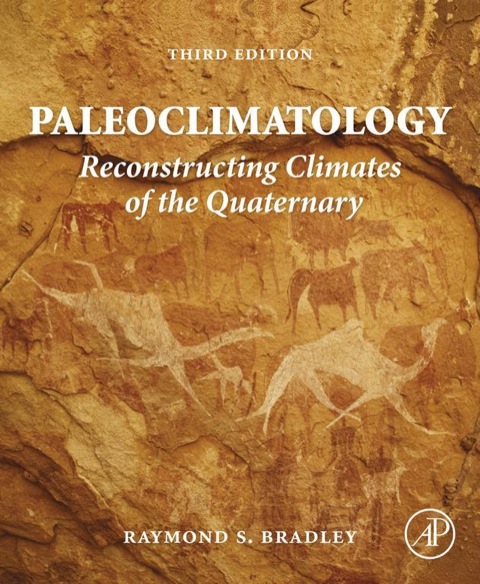Description
Efnisyfirlit
- Cover image
- Title page
- Table of Contents
- Copyright
- Dedication
- Acknowledgments
- Front Cover Photograph
- Holocene Rock Art from the Northwestern Flanks of the Ennedi Highlands, Eastern Sahara, Chad
- References
- Foreword
- Preface to the Third Edition
- Chapter 1. Paleoclimatic Reconstruction
- Abstract
- 1.1 Introduction
- 1.2 Sources of Paleoclimatic Information
- 1.3 Levels of Paleoclimatic Analysis
- 1.4 Modeling in Paleoclimatic Research
- References
- Chapter 2. Climate and Climatic Variation
- Abstract
- 2.1 The Nature of Climate and Climatic Variation
- 2.2 The Climate System
- 2.3 Feedback Mechanisms
- 2.4 Energy Balance of the Earth and Its Atmosphere
- 2.5 Timescales of Climatic Variation
- 2.6 Variations of the Earth’s Orbital Parameters
- 2.7 Solar Forcing
- 2.8 Volcanic Forcing
- References
- Chapter 3. Dating Methods I
- Abstract
- 3.1 Introduction and Overview
- 3.2 Radioisotopic Methods
- References
- Chapter 4. Dating Methods II
- Abstract
- 4.1 Paleomagnetism
- 4.2 Dating Methods Involving Chemical Changes
- 4.3 Tephrochronology
- 4.4 Biological Dating Methods
- References
- Chapter 5. Ice Cores
- Abstract
- 5.1 Introduction
- 5.2 Stable Isotope Analysis
- 5.3 Dating Ice Cores
- 5.4 Paleoclimatic Reconstruction from Ice Cores
- References
- Chapter 6. Marine Sediments
- Abstract
- 6.1 Introduction
- 6.2 Paleoclimatic Information from Biological Material in Ocean Cores
- 6.3 Oxygen Isotope Studies of Calcareous Marine Fauna
- 6.4 Paleotemperatures from Relative Abundance Studies
- 6.5 Paleotemperature Reconstruction from Sediment Geochemistry
- 6.6 Oceanographic Conditions at the Last Glacial Maximum (LGM)
- 6.7 Paleoclimatic Information from Inorganic Material in Marine Sediments
- 6.8 Thermohaline Circulation of the Oceans
- 6.9 Changes in Atmospheric Carbon Dioxide: The Role of the Oceans
- 6.10 Abrupt Climate Changes
- References
- Chapter 7. Loess
- Abstract
- 7.1 Chronology of Loess-Paleosol Sequences
- 7.2 Paleoclimatic Significance of Loess-Paleosol Sequences
- References
- Chapter 8. Speleothems
- Abstract
- 8.1 Isotopic Variations in Speleothems
- 8.2 Tropical and Subtropical Paleoclimate Variability from Speleothems
- 8.3 Speleothems and Glacial Terminations
- 8.4 Millennial to Centennial Scale Changes
- 8.5 Late Glacial and Holocene Records
- 8.6 Stalagmite Records of the Last Two Millennia
- 8.7 Paleoclimatic Information from Periods of Speleothem Growth
- 8.8 Speleothems as Indicators of Sea-Level Variations
- References
- Chapter 9. Lake Sediments
- Abstract
- 9.1 Sedimentology and Inorganic Geochemistry
- 9.2 Varves
- 9.3 Pollen, Macrofossils, and Phytoliths
- 9.4 Ostracods
- 9.5 Diatoms
- 9.6 Stable Isotopes
- 9.7 Organic Biomarkers
- References
- Chapter 10. Nonmarine Geologic Evidence
- Abstract
- 10.1 Introduction
- 10.2 Periglacial Features
- 10.3 Snowlines and Glaciation Thresholds
- 10.4 Mountain Glacier Fluctuations
- 10.5 Lake-level Fluctuations
- References
- Chapter 11. Insects and Other Biological Evidence from Continental Regions
- Abstract
- 11.1 Introduction
- 11.2 Insects
- 11.3 Former Vegetation Distribution from Plant Macrofossils
- 11.4 Peat
- References
- Chapter 12. Pollen
- Abstract
- 12.1 Introduction
- 12.2 The Basis of Pollen Analysis
- 12.3 Pollen Rain as a Representation of Vegetation Composition and Climate
- 12.4 Quantitative Paleoclimatic Reconstructions Based on Pollen Analysis
- 12.5 Paleoclimatic Reconstruction from Long Quaternary Pollen Records
- References
- Chapter 13. Tree Rings
- Abstract
- 13.1 Introduction
- 13.2 Fundamentals of Dendroclimatology
- 13.3 Dendroclimatic Reconstructions
- 13.4 Isotopic Dendroclimatology
- References
- Chapter 14. Corals
- Abstract
- 14.1 Coral Records of Past Climate
- 14.2 Paleoclimate from Coral Growth Rates
- 14.3 Luminescence in Corals
- 14.4 δ18O in Corals
- 14.5 δ13C in Corals
- 14.6 Δ14C in Corals
- 14.7 Trace Elements in Corals
- 14.8 Fossil Coral Records
- References
- Chapter 15. Historical Documents
- Abstract
- 15.1 Introduction
- 15.2 Historical Records and Their Interpretation
- 15.3 Regional Studies Based on Historical Records
- 15.4 Records of Climate Forcing Factors
- 15.5 Climate Paradigms for the Last Millennium
- References
- Appendix A. Further Considerations on Radiocarbon Dating
- A.1 Calculation of Radiocarbon Age and Standardization Procedure
- A.2 Fractionation Effects
- References
- Appendix B. Internet Resources in Paleoclimatology
- References
- Index






Reviews
There are no reviews yet.